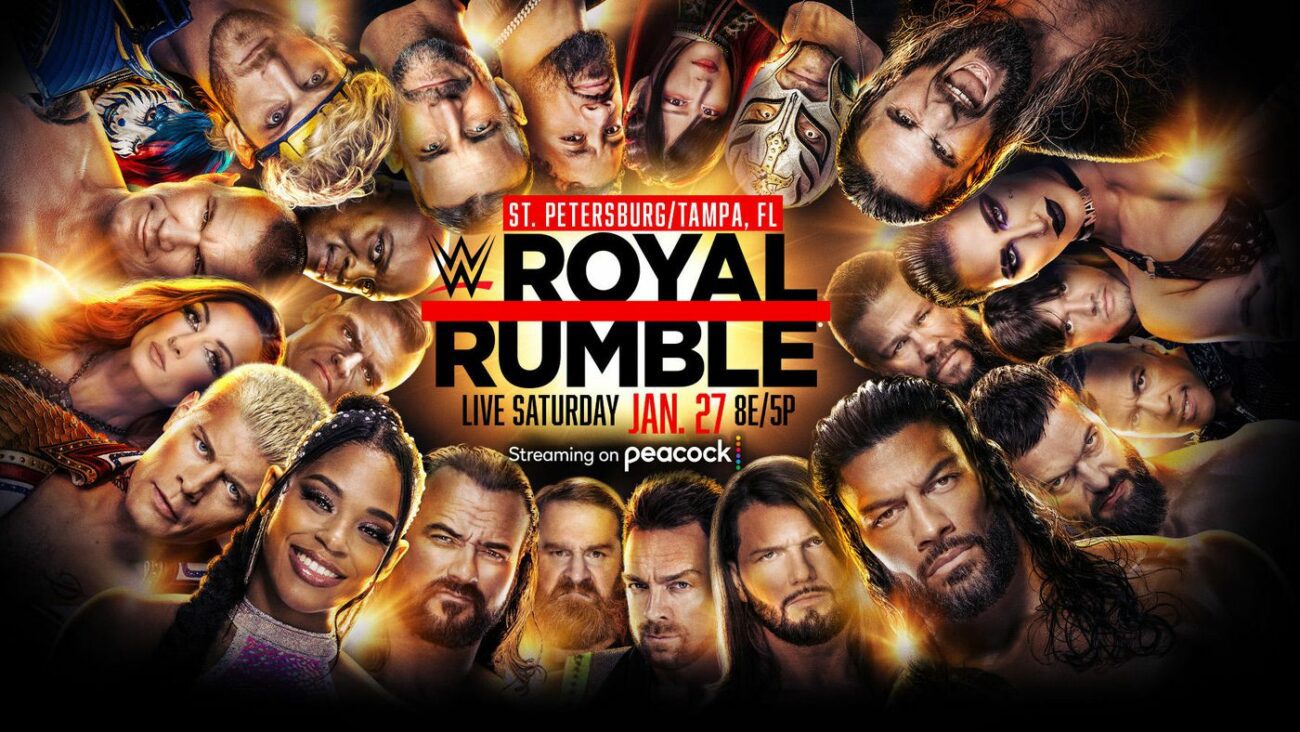Tag teams need several things to succeed. Chemistry and fan investment are two critical components but just as important is a tag team name, one on which the reputation and the image of the team is built. Some promoters back in the day were evidently uninspired and chose to give their new collective a pre-owned wrestling moniker. These are 10 tag teams who utilised a hand-me-down handle from an already-existing tandem.
Please note that for this list, only teams unconnected and with different personnel will be considered so teams with a constant member such as The Midnight Express will be exempt. ‘New’ versions of tag teams, such as The New Rockers or The New Blackjacks, will also not be counted.
The Unholy Alliance
In 2000, after Tajiri was ejected from Don Callis’s The Network stable, he joined forces with Mikey Whipwreck. Two dynamic, smaller wrestlers who earned the respect of fans through their unorthodox character work and in-ring steel, the partnership seemed to be a marriage between two stars on different career trajectories, as Tajiri had climbed the card while Whipwreck was slipping down. Managed by The Sinister Minister, they were given the collective name of The Unholy Alliance.
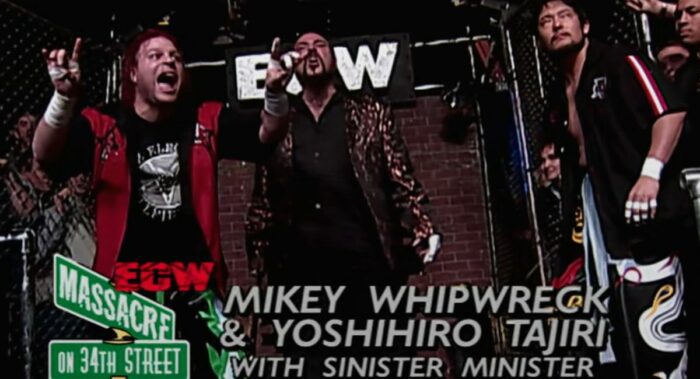
At 2001’s Midtown Massacre, the team won a one-night tournament to be crowned the ECW World Tag Team champions. Having then quickly lost the belts, they remained a fixture of the ECW tag team division, feuding most prominently with The Full Blooded Italians (FBI).
At ECW’s final Pay-Per-View (PPV) Guilty As Charged, they became number one contenders to the tag belts, although their match would never come. The trio would reunite at One Night Stand 2005 when Whipwreck and Sinister Minister accompanied Tajiri in his three-way dance match.
In more recent years, however, the name has become more synonymous with the short-lived union between Big Show and The Undertaker after the line was said by Jim Ross on commentary.
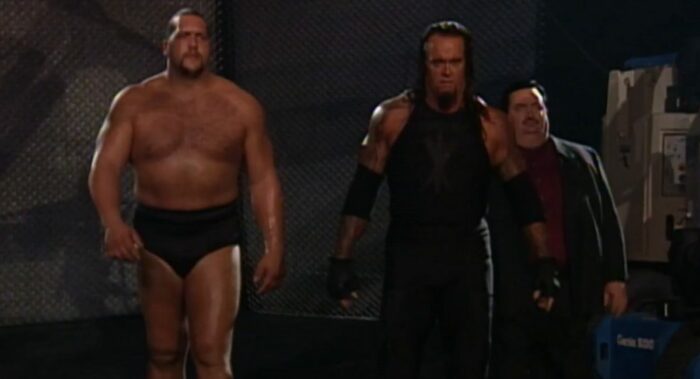
They captured the World Tag Team belts at SummerSlam 1999, beating Kane and X-Pac. Their most famous match, however, was on SmackDown in the only tag team buried alive encounter when they took on The Rock ’N’ Sock Connection.
The two had an uneasy on-screen and off-screen relationship. Big Show later commented on the ‘Broken Skull Sessions’ that “The Undertaker was relentless on me. He would blister me about bumping too much, overselling, not enough selling…” adding that ‘Taker commonly waited at the backstage Gorilla Position to chastise his performances.
‘The Dead Man’ started subtly converting to his biker moniker during this run, wearing a bandana and sunglasses. He was also suffering from an injury, which hampered his in-ring work. ‘Taker was often on commentary rather than wrestle and the duo lost their second tag titles when Mideon was pinned after he and Viscera substituted for the leader of The Ministry of Darkness.
The team ended when The Undertaker took time off to heal from the injuries he had worked through.
(Two) Dudes With Attitudes
Like with the WWF’s Unholy Alliance, Two Dudes With Attitudes has become a retroactive title, one not used during the group’s lifespan.
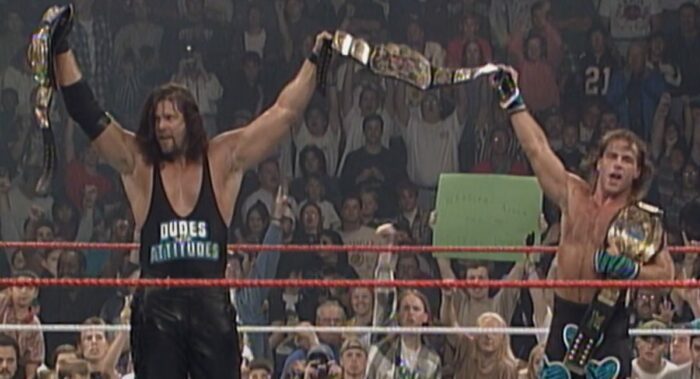
The name is used to refer to Shawn Michaels and Diesel, two Kliq members who also became on-screen allies.
The team first came together in 1993 when a then-unnamed near-seven-footer arrived in the WWF as “The Heartbreak Kid”’s henchman. Over the next 18 months, the two would dominate WWF programming, eventually winning the tag belts in August 1994 before disbanding after that year’s Survivor Series when Michaels inadvertently superkicked Diesel.
The two would reunite in 1995 and capture the tag belts from Owen Hart and Yokozuna, although the reign was fleeting, being scrubbed off the next night after Diesel pinned “The Rocket”, who was not a listed participant in the contest.
The similarly-named Dudes With Attitudes was also a WCW faction for a brief time, formed as a battalion against The Four Horsemen. The alliance comprised a ragtag group of babyfaces who made sure Sting had a fair match at the Great American Bash 1990 against NWA World Heavyweight champion Ric Flair.
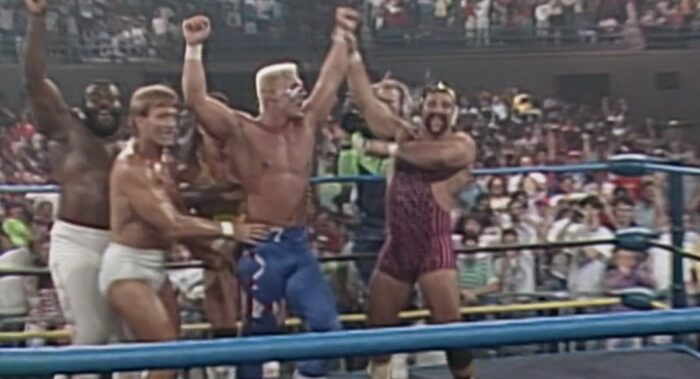
After members El Gigante, The Junkyard Dog, and Paul Orndorff fought Arn Anderson, Barry Windham, and Sid of The Horsemen earlier in the night, they—alongside The Steiner Brothers—surrounded the ring during “The Franchise”’s world title shot. They later celebrated with a jubilated Sting when he won his first world title.
AEW made a nod to the WCW team when Sting, Darby Allin, and Shingo Takagi were given the name at Forbidden Door 2022.
The Diamond Mine
In June 2021, NXT saw the debut of the Diamond Mine stable when a number of hooded men assaulted Kashida.
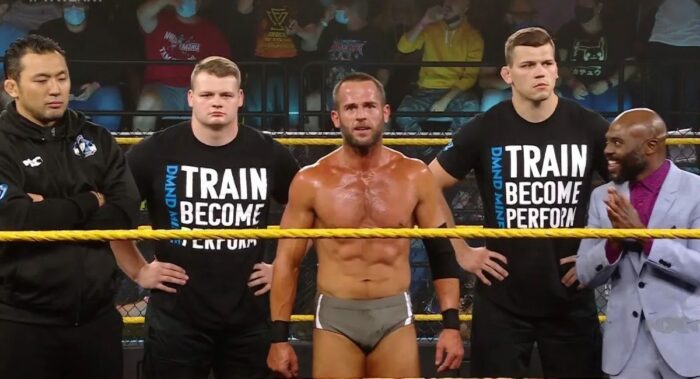
Not long after the breakup of The Undisputed Era, Roderick Strong became the leader of the Diamond Mine, also featuring Tyler Rust and Hachiman, managed by Malcolm Bivens. The group was named as such due to the nickname for Rust coined by Bivens, “Diamond in the Rust”.
Although Roderick Strong would pick up the Cruiserweight title belt, the group’s potential was never fully realised as the founding members would all shortly be shuffled out of the company. Rust was ousted with a swathe of other talents in August, Hachiman was out in January, and Malcolm Bivens left in April. Roderick Strong’s contract expired in late 2022, and he debuted in AEW the next year.
The team would live on with members Ivy Nile and The Creed Brothers, the latter of whom have held the NXT Tag Team titles and won the revered Dusty Rhodes Tag Team Classic.
It was not the first Diamond Mine stable, as the same mantle had been used by a WCW faction headed up by Diamond Dallas Page.
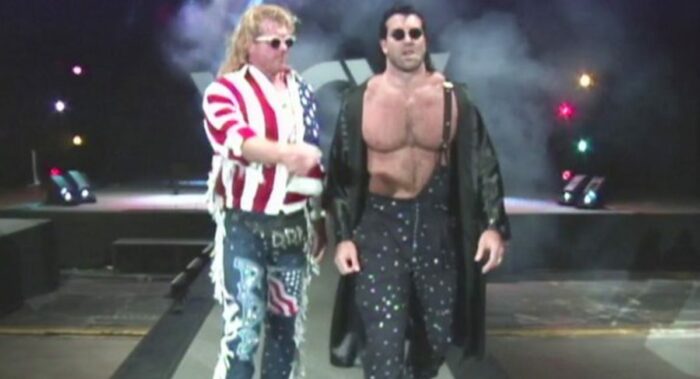
Then a manager, The Diamond Mine was DDP’s pet project, most notable for introducing to the world the gimmicks of The Diamond Studd and Vinnie Vegas. The roles were played by Scott Hall and Kevin Nash respectively—men who would go on to become two of the biggest wrestlers in the world over the next decade.
Hall in particular was crafted into the Scott Hall we would all come to know, undergoing a makeover under DDP that saw him dye his hair dark black, shave off his moustache, and start wielding a toothpick.
Another notable Diamond Mine member was Scotty Flamingo, who would be a future ECW world champion as Raven.
When Studd left to pursue a WWF career, Diamond Dallas Page—then 35—decided to start training to become a wrestler at WCW’s Powerplant training facility.
The concept of The Diamond Mine itself was a hangover from the AWA’s Diamond Exchange, a faction that included Curt Hennig, Colonel DeBeers, and…
Bad(d) Company
The tag team Badd Company wrestled across all three major promotions in the 1990s—WWE, WCW, and ECW—although they had their greatest success in the American Wrestling Association.
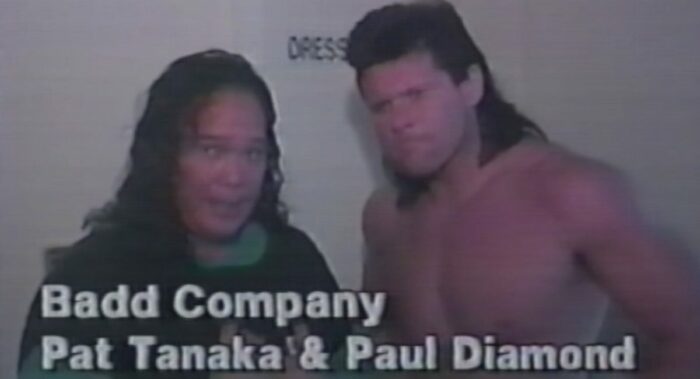
Since their 1986 debut, the combination of Pat Tanaka and Paul Diamond had been a successful duo in the Championship Wrestling Association, later making the jump to the AWA in 1988. In Verne Gagne’s promotion, the team would become year-long tag champions, beating The Midnight Express for the belts. The alliance feuded with the Guerreros and would tag alongside Madusa against The Top Guns and Wendi Richter at the promotion’s only PPV SuperClash III.
The team would be rekindled in the WWF when Tanaka’s Orient Express teammate Akio Sato departed from the WWF. The Tanaka-Diamond formation would only wrestle two PPV matches, but they were two widely acclaimed encounters. In particular, their 1991 Royal Rumble clash with The Rockers was rated four stars by Dave Meltzer and was described as being the WWF’s best PPV match since Steamboat versus Savage.
The duo’s last major run was in Eastern Championship Wrestling where, although they would never win the tag belts, they were a cornerstone of the tag title scene. The team most famously fought with The Public Enemy, including an infamously horrific body count match which featured an explosive set piece so botched that Diamond called it “the most embarrassing situation I was ever involved in.”
Around the same time Badd Company were making waves in the United States, Bad Company (with a singular d) was becoming mighty popular in Canada.

The team, based in Canada’s Stampede Wrestling, was comprised of two Hart family dungeon graduates, Brian Pillman and Bruce Hart. A team with an exciting and fast-paced style, they were Stampede Wrestling International tag champions for 439 days over two reigns. They were described by The Wrestler magazine as “the team to beat in ‘88.” The two fought The Funk Brothers in the penultimate match of Stu Hart’s 50th Anniversary show.
Bruce Hart claims that the group would inspire another Brian Pillman tag team: The Hollywood Blonds.
The Hollywood Blonds
Today, the most remembered iteration of The Hollywood Blonds was formed in 1993 and featured two men pegged as stars to watch for WCW, Brian Pillman and Steve Austin.

The team gave both men a chance to develop their characters: Pillman to break his pure, white meat babyface reputation, and Austin to be more front and centre than he had been before. They offered wrestlers a chance at “a brush with greatness” whilst making old-timey film camera-cranking gestures with their hands.
Austin recalled that upon being told he was to be teamed with “Flyin’ Brian”, he was “not happy at all” but took pride in the fact they soon “took that ramshackle tag team, turned it into [a team who] had great success in a short amount of time [and] got over.” Together, Pillman and Austin won the combined NWA and WCW tag belts and battled some of the industry’s top names, such as Ric Flair, Ricky Steamboat, and Arn Anderson. Pro Wrestling Illustrated crowned them the 1993 tag team of the year.
After an injury to Pillman (which caused Austin to defend the belts with substitute partner Lord Steven Regal), the team imploded. Although they seemingly broke up without reason, it was for the best as, within a few years, both would become some of the most talked about workers in the business.
They were not WCW’s only Hollywood Blonds, as the sexually ambiguous team of Lenny Lane and Lodi was named The West Hollywood Blonds in 1999.
Pillman and Austin were not even the first Hollywood Blonds—in fact, there were three different teams beforehand, such as Rip Rogers and Ted Oates in Jim Crockett Promotions and Larry Sharpe and Jack Evans in the WWF and later World Wrestling Council.
The most noteworthy team consisted of Jerry Brown and Dale Roberts. Wearing sunglasses and effeminate clothing, they existed from 1970-1977.
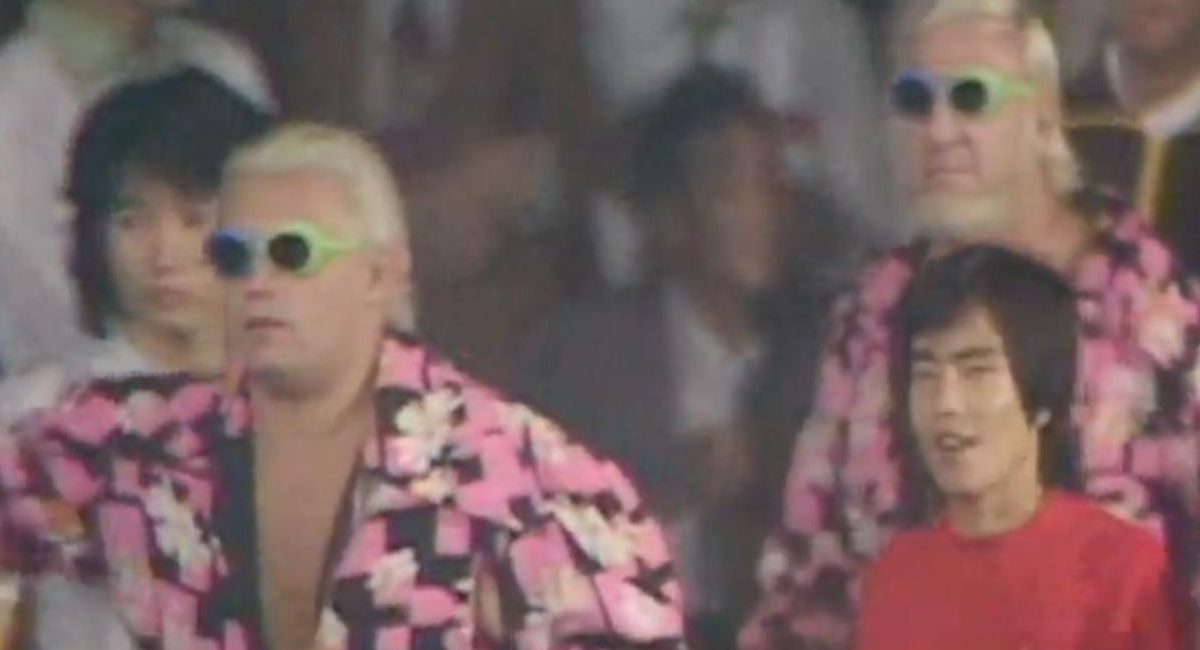
Alongside manager Oliver Humperdink, they had successful championship runs across the US in Florida, Georgia, and California, amongst other territories.
They were heat magnets everywhere they went, getting particular hate in Canada. As Brown reflected: “We acted like we were queers…It got so bad in Montreal that Buddy [would] get into the taxi and snuggle up to the driver; it got so bad we couldn’t catch a ride in Montreal.” Fans also tried to tip over taxis the duo travelled in.
The team can also be partly credited for wrestling in the biggest live show in Montreal history when performing in front of nearly 30,000 fans. They took on legendary babyfaces Bruno Sammartino and Edouard Carpentier. By the time the team disbanded, they had won the Tri-State version of the NWA United States Tag Team titles, Eddie Graham’s CWF belts, and the NWA Mid-Atlantic Tag Team championships.
Dale Roberts would see greater commercial success in The Fabulous Freebirds as Buddy Roberts.
The Pitbulls
The original Pitbulls team made their debut in 1992 and would become a top team in the mid-90s ECW, gaining a reputation as brawling powerhouses. The duo later joined Raven’s Nest but, after a falling out, won the ECW World Tag Team championships from the team of Raven and Stevie Richards at 1995’s Gangsta’s Paradise event.
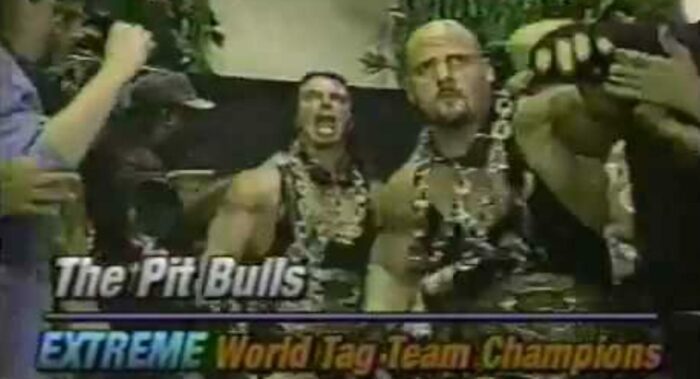
During their tenure, they feuded with several teams, including The Eliminators, comprised of Perry Saturn and John Kronus. Both men also witnessed solo success, winning the Television title once each. Pitbull #1 (Gary Wolfe) won his in 1994, beating JT Smith and losing it to Mikey Whipwreck whilst Pitbull #2 (Anthony Durante) won his in 1996, beating Shane Douglas and later losing it to a young Chris Jericho.
The team was managed for a time by Francine, whose ECW debut came with The Pitbulls before she ditched them and became manager of “The Franchise” Shane Douglas. Douglas was also responsible for The Pitbulls’ most memorable storyline. After a botched DDT from Douglas, Pitbull #1 had his neck legitimately broken, forcing him to wear a halo whilst he recuperated. “The Franchise” further yanked Pitbull #1’s halo during an in-ring scuffle, leading to a riotous crowd attempting to ambush Douglas, who stated: “I didn’t know that I was going to get out of that arena in one piece.” This gave Pitbull #2 a featured match against Douglas for the TV title at ECW’s first PPV, Barely Legal.
The gimmick later served as inspiration for Kid Kash and Jamie Noble, who wrestled under the same name in the WWE.

Formed in 2006, Noble had just returned to the company whilst Kid was shortly off of a run with the Cruiserweight championship.
The two stars wore dog collars and barked and bit wrestlers after Vince McMahon reportedly told them, “You two remind me of two f**king dogs; that’s the way I want you to wrestle.” As a team, they only wrestled 14 televised matches, largely on c-show Velocity, defeating teams such as Funaki and Scotty 2 Hotty on several occasions.
Their career high point was at the Great American Bash 2006, where they challenged Paul London and Brian Kendrick for the WWE Tag Team titles. Their final match was a number one contender’s bout against KC James and Idol Stevens (the future Damien Sandow).
The group disbanded by the end of the year, with original member Gary Wolfe apparently still holding the copyright for the name. Kash’s days were already limited after he was caught smoking weed backstage at a WWE event.
The Dynamic Duo
The first version of The Dynamic Duo featured Gino Hernandez and Tully Blanchard. Winning the Texas All-Star USA Tag Team titles on five occasions and headlining the Sam Houston Coliseum on a number of occasions, together they were the top heels in Texas based on box-office drawing power.
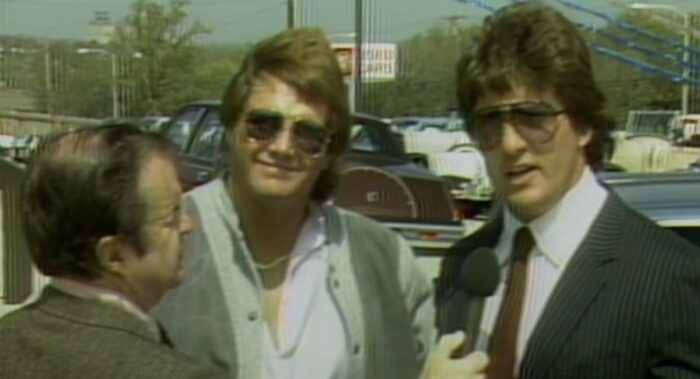
More successful was the line-up consisting of Hernandez and Chris Adams. With the British grappler in WCCW, the team would have a high-profile feud with The Von Erichs, generating high TV ratings and revenue even outside their native Texas.
In front of 50,000 fans in May 1986, Hernandez—known as “The Handsome Halfbreed from Hyde Park”—destroyed the newly-won car of The Von Erichs. The Duo’s gimmick included bringing gold scissors to the ring to cut the hair of fallen opponents and they got their comeuppance after losing a hair vs hair match to The Von Erichs and having their own heads shaved. As a result, they were forced to wear masks.
After two reigns as NWA American Tag Team championships, the team would break up, leading to a feud between Adams and Hernandez where “Gentleman” Chris was kayfabe blinded after having The Fabulous Freebirds’ hair cream rubbed in his eyes.
Javier Ojst of Pro Wrestling Stories notes: “The hatred amongst the former Dynamic Duo members before Gino died and the blinding of his former tag partner Chris Adams felt so real to the fans that they demanded authorities investigate Adams as a possible suspect in Gino’s death.”
In 1995, Jim Cornette’s Smoky Mountain Wrestling brought back the team’s name for their new alliance of Al Snow and Unabomb (the future Kane).

During a long-running rivalry with The Rock ‘N’ Roll Express, the team would pick up the SMW tag belts at Bluegrass Brawl III in a coal miner’s glove match. It was the first title Glenn Jacobs had held in his wrestling career.
During their three-month reign, they feuded with The Armstrong Brothers and The Batten Twins whilst being a part of the larger Militia stable, led by Cornette. The faction also included Smoky Mountain world champions Terry Gordy, Buddy Landel, and Tommy Rich.
Both would rack up talking points in the singles division. Snow won the MTW Heavyweight belt from Marty Jannetty whilst Unabomb would face future kayfabe brother and rival The Undertaker at SuperBowl of Wrestling.
The team would drop the straps to The Thugs, the tag combination of The Dirty White Boy and Tracy Smothers—two of the most popular performers in the promotion. After a loser-of-the-fall leaves town encounter, the team dissolved. Both would subsequently find themselves in the WWF; Snow as Leif Cassidy and Unabomb as Isaac Yankem DDS.
The Suicide Blondes
In 1990, INXS released the worldwide hit “Suicide Blonde”, which was a US Hot 100 top 10 and Canadian chart-topper. The track’s name gave birth first to one of the biggest teams in early-day ECW.
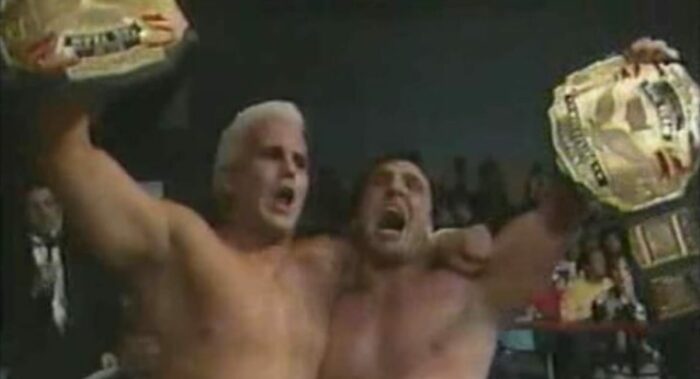
Back in the days of Eastern Championship Wrestling, the name was used by the trio of former ECW world champion Sir Johnny Hotbody, Sir Chris Michaels, and Sir Chris Candido.
The group won their first ECW tag titles in a match taped just a day after Tony Stetson and Larry Winters had won the straps in Radnor, Philadelphia. The match, later aired on Hardcore TV, ended after Hotbody illegally hit Winters with a chain. Once champions, the team defended the belts under the so-called “Freebird Rule”, which allows fluidity for which wrestlers can defend the belts in a multi-man collective.
A matter of weeks later, The Super Destroyers beat them for the belts although The Blondes immediately won them back in a match with The Blondes’s career on the line. They would relinquish the championships when Candido left for SMW in July 1993.
Even long after the faction had folded, Candido still continued to utilise the blonde moniker, including for his finisher, dubbed the blonde bombshell.
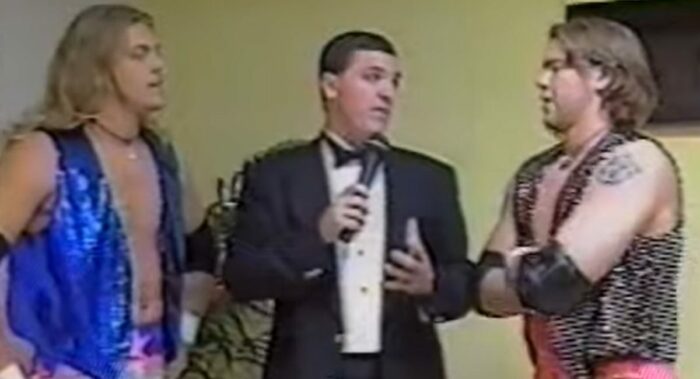
Another team with that same name would not become known commercially until its members made it big in the WWF: Edge and Christian.
Under the names Christian Cage and Sexton Hardcastle, by the mid-late 1990s, they had gained a reputation on the Canadian independent scene. In addition, they worked for promotions such as Insane Championship Wrestling out of Michigan.
According to Edge’s autobiography, they had a “long-haired, Canadian, white meat babyface shtick,” and reportedly had so little money they had to once phone Christian’s parents for money for Greyhound bus tickets.
They had several different names across their run—such as The Canadian Rockies in Japan—and worked with revered names such as Rick Martel and Bad News Brown. They also joined the Thug LiFe stable, which included future colleagues Rhyno and Test.
The Super Destroyers
The aforementioned Super Destroyers were a further team integral to ECW’s roots.
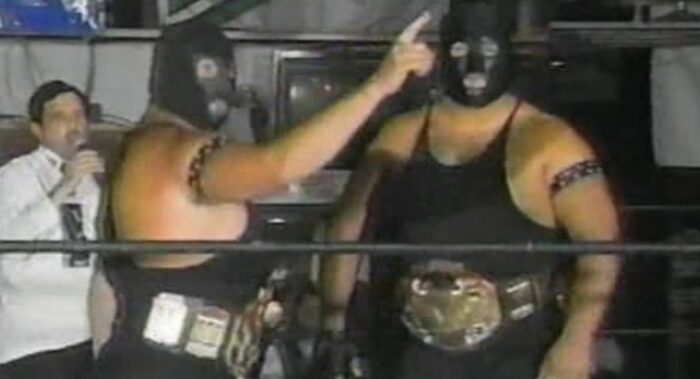
First teaming in early 1992, The Super Destroyers were comprised of Super Destroyer #1 (AJ Petrucci) and Super Destroyer #2 (Doug Stahl). With their manager Hunter Q. Robbins III at their side, they became the inaugural ECW World Tag Team champions in June 1992.
During their reign, the super heavyweight tandem managed to triumph in a title vs title match against the WWA tag titleholders and compete on the first edition of ECW Hardcore TV. Their 283-day reign is the longest in the history of the belt. Dethroned by Larry Winters and Tony Stetson, they would have a second tag title reign, although it lasted less than a day as, with the help of an interfering Chris Candido, they dropped them to The Suicide Blondes the same day they won them.
Fun fact: AJ Petrucci is the cousin of Gene Snitsky.
Bill and Scott Irwin were The Super Destroyers in a number of companies, including WCCW. There, they wrestled top stars like Kerry Von Erich, Dusty Rhodes, and Andre The Giant and teams such as The Briscos and The Fabulous Freebirds.
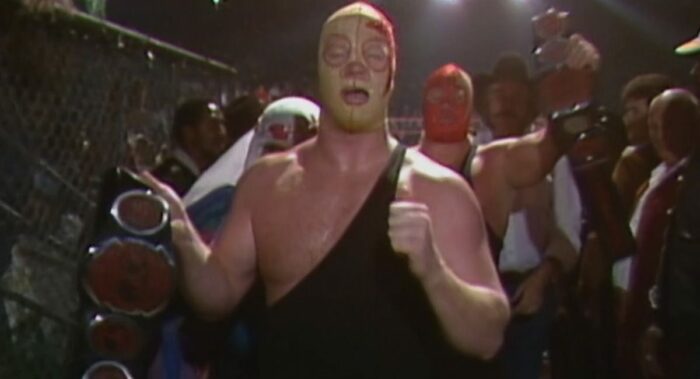
The team, managed by Skandor Akbar, were constantly gaining and dropping the NWA American Tag Team titles, which they held on four occasions.
The gimmick was originally done solo by Scott when wrestling in a mask. In a fitting bit of booking, the gimmick would also end when both men were demasked. From then on, they were The Long Riders, who had an AWA run, challenging for the AWA World Tag Team titles at WrestleRock 1986 against Curt Hennig and Scott Hall.
Scott died in 1987 from a brain tumour, aged just 35. “Wild” Bill Irwin would go on to have a WWF run as the critically panned ice hockey player The Goon, a gimmick allegedly originally planned for Chris Jericho.
The Executioners
In 1976, the WWWF brought in a mysterious masked duo called The Executioners.
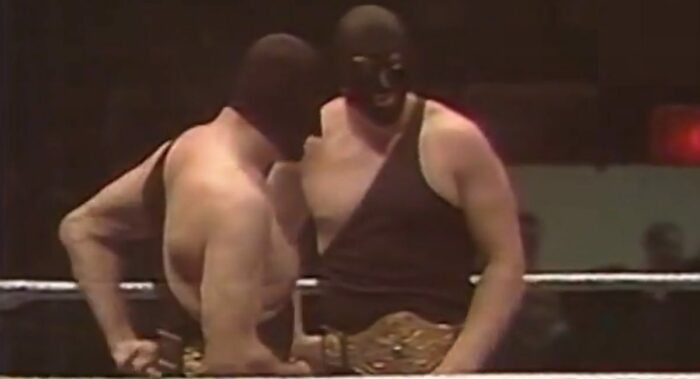
The mask was necessary for one member, Killer Kowalski, who had already gained notoriety in the WWF for his feud with WWWF champion Bruno Sammartino. Under the other mask was Big John Studd, a 6’10 trainee of Kowalski who would become a star in the early Golden Era of the WWF in the mid-late 1980s. Author Brian Soloman comments that the tall twosome were put together so Studd could “get experience without being overshadowed” by his grappling mentor.
In May 1976, they would win the WWF World Tag Team titles from Louis Cerdan and Tony Parisi, belts that they would hold for nearly half a year. After a third Executioner, played by Nikolai Volkoff, interfered in a match to help the team, the team were stripped of the belts. The Executioners then failed to re-win the belts in a multi-team tournament, eventually won by Chief Jay Strongbow and Billy White Wolf (later General Adnan in the WWF).
Another and very different team of Executioners rocked up in the WWF in the early 1990s, with the hooded characters played by perennial journeymen Duane Gill (the future Gillberg) and Barry Hardy.
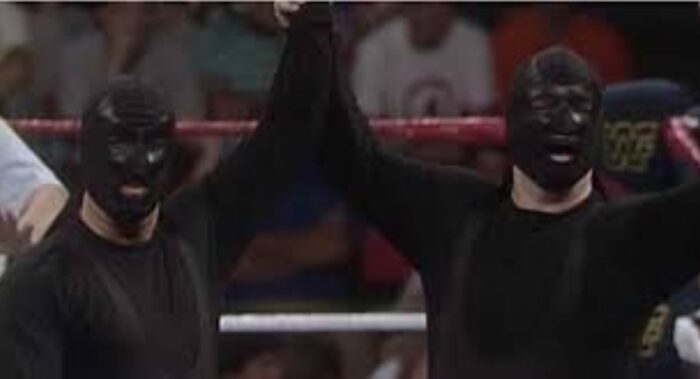
Losing to many of the high-calibre teams of the day, they challenged both The Legion of Doom and The Headshrinkers for the World Tag Team title belts, even if they never stood a chance of succeeding. Most notably, they would appear on the very first edition of Monday Night Raw where they were fed to The Steiner Brothers.
Teaming until late 1994, the team’s members also invariably competed in solo action as The Executioner before getting axed—yes, pun very much intended.


